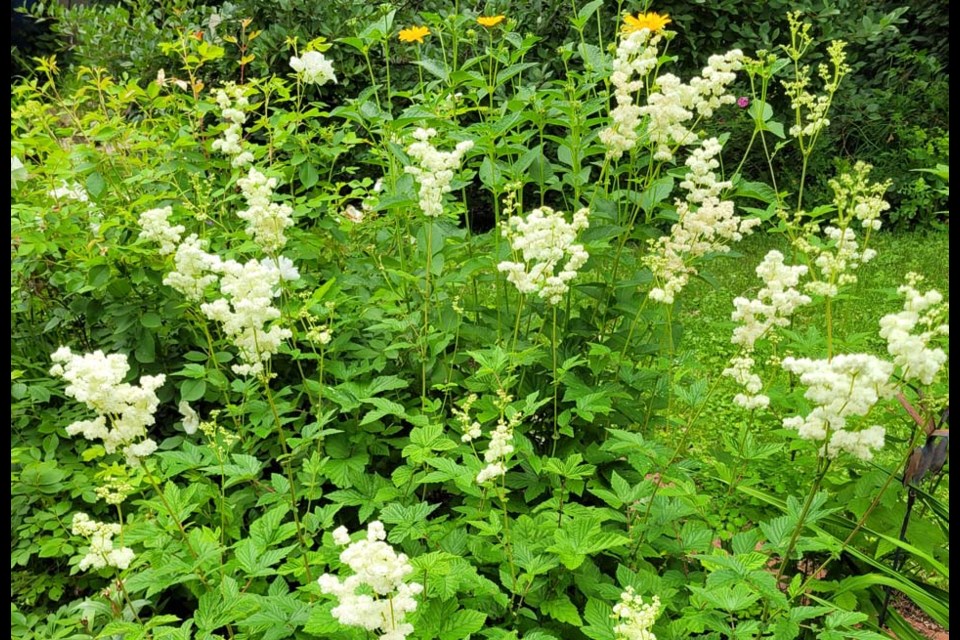Here are some additional white accent plants for your garden in summer.
For the shorter groundcover plants for your white and silvery garden, also think foliage. ‘Silvermound’ artemisia (Artemesia schmidtiana) forms a silver cushion. It usually is good for one or two years, then dies out in the middle. I have not been successful in dividing and getting a nice rosette in spring. For me, this is a short-lived perennial.
‘Silver Brocade’ artemisia (Artemesia stelleriana) has been a good ground cover for me. It propagates easily, can be somewhat invasive, but is easy to control and always looks pretty. It gives the border a regal finish at the edges.
Another silver accent for a white border can be the native sage, but it is a pretty aggressive spreader. I have taken it out of my sunny beds because it is just too prolific. I find it grows well in the shade and is not as aggressive there.
Pearl yarrow (Achillea ptarmica) ‘The Pearl’ is easy to grow, drought-tolerant and a beautiful addition to the white garden. It is a great replacement for the banned baby’s breath. About 45cm high, the green ferny stems and double white flowers look great in flower arrangements, both fresh and dried. It blooms in July and August. Some say it is invasive, but I have not found it so. When it got shaded by some taller perennials nearby, it disappeared.
Mock orange (Philadelphus coronarius), a flowering shrub, comes in different varieties and sizes, so pay attention to the plant tags as to mature size. Philadelphus x virginalis ‘Miniature Snowflake’ grows to a height of about 90cm, whereas many others can be well over 150cm tall and wide. Mock orange is a delight when in bloom because of its distinctive, lovely scent. It is great to bring indoors as there are always abundant flowers.
A couple of years ago, I picked up Valerian (Valeriana) at a fall plant exchange. Being short on sunny spaces, I put it in a semi-shady spot. This year it shot up to a height of 2m and produced large, beautiful, pure white, roundish flower heads. At its base, new plants are already developing, which to me indicates it might be somewhat invasive. After one of our rain storms, the hollow stalks bent and I prematurely deadheaded all the flowers. I will keep a careful eye on it and might take it out if it proves too invasive. A better option for the gardener may be White Fleece Flower (Persicaria polymorpha), which is also tall and stately, takes a bit longer to establish, but seems to stay put in one place, slowly producing additional flower stalks each year. The flowers on Persicaria are more elongated and tend to be creamier in colour.
Meadowsweet (Filipendula ulmaria) has white fluffy flowers. It has been naturalized in North America but hails from Europe and Western Asia. It grows about 100cm tall in my yard and flowers in mid-summer. The name dates from the 16th century, when the flowers were used to sweeten mead.
Hydrangeas in my yard bloom near the end of July. In other gardens, many varieties are already in full bloom earlier in the season. Hydrangeas are being bred to be more cold-tolerant and there are many white varieties to choose from. The blues and pinks still are only marginally hardy in our zone. When purchasing hydrangeas read the plant labels for hardiness zones,
These white flowers should give you a start on a white Sissinghurst-like garden. All plants mentioned do best in full sun. The Filipendula will tolerate partial shade. The one drawback, especially if you stick with only white blooms, is that on the petalled flowers, such as mock orange, peonies and roses, thrips can be a problem.
As flowers bloom at different times, when designing with white plants, it is important to also pay attention to foliage and the different shades of green that will accent your garden throughout the year.
This column is provided courtesy of the Saskatchewan Perennial Society.
(SPS; [email protected]). Check our website (www.saskperennial.ca) or Facebook page (www.facebook.com/saskperennial) for a list of upcoming gardening events.




